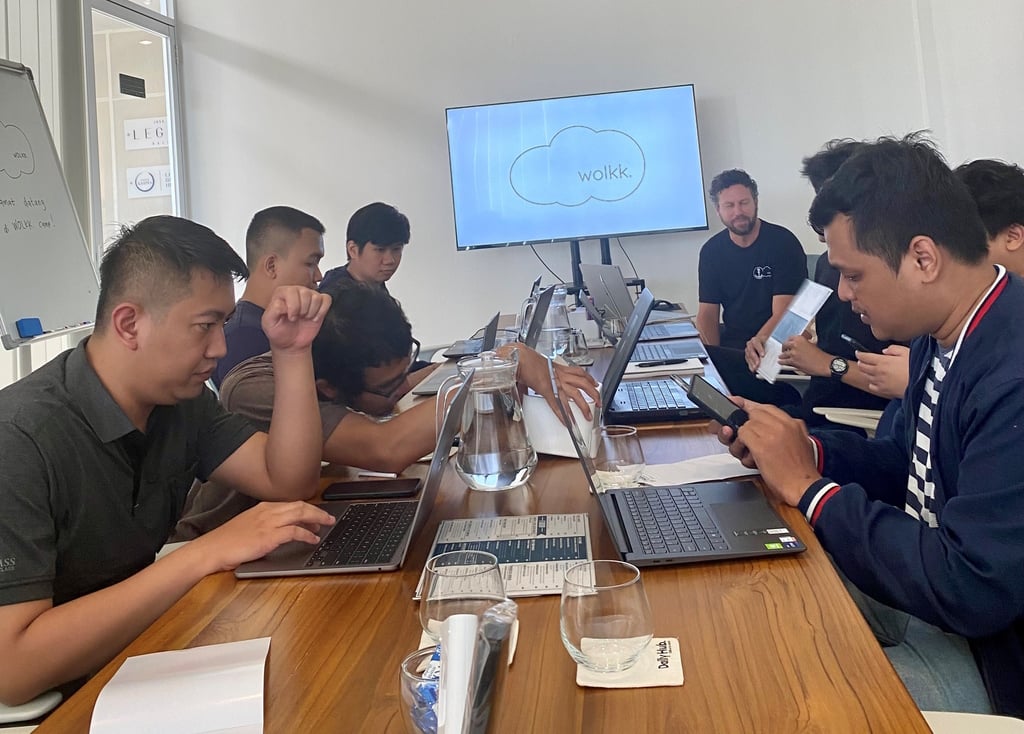Innovative IT-Outsourcing Strategies: The Role of Augmented Teams and Outstaffing in Advancing Software Development
In today's fast-paced world, businesses are constantly striving for a competitive edge. One approach that has gained traction is IT-outsourcing, which involves delegating certain tasks or processes to external service providers. This allows organizations to focus on their core competencies while leveraging the expertise and resources of specialized IT partners. By doing so, they can improve efficiency, reduce costs, and achieve better results in their software development projects.
However, traditional IT-outsourcing models have their limitations. For instance, they often involve a loss of control over the development process, communication barriers, and a lack of flexibility. As a result, companies are exploring innovative IT-outsourcing strategies such as offshoring, dedicated teams, outstaffing, and augmented teams to overcome these challenges and enhance their software development capabilities.
In this article, we will delve into the world of IT-outsourcing, examine its evolution, and explore how these cutting-edge strategies are transforming the software development landscape.

Understanding Offshoring and its Evolution
Offshoring, a prominent IT-outsourcing model, refers to the relocation of business processes or services to another country. This strategy gained popularity as companies sought to capitalize on the cost advantages and skilled labor pools available in countries like India, China, and Eastern Europe. By offshoring software development tasks, organizations could significantly reduce labor costs, streamline operations, and maintain round-the-clock productivity.
However, offshoring has its drawbacks. Time zone differences, language barriers, and cultural disparities can lead to communication issues and misunderstandings. Additionally, the lack of direct oversight can hinder quality control and compromise the overall project outcome. To address these concerns, businesses began exploring alternative IT-outsourcing models that offered more control, flexibility, and collaboration.
The Concept of Dedicated Teams in Software Development
One such model is the dedicated team approach, which involves engaging a group of skilled professionals dedicated exclusively to a specific project or client. These teams typically operate from the service provider's premises but work under the client's guidance and follow their processes and methodologies. This arrangement allows for greater control, collaboration, and alignment with the client's objectives and values.
Dedicated teams offer several advantages over traditional offshoring models. First, they allow clients to handpick the team members based on their expertise and fit with the project requirements. This ensures that the team possesses the necessary skills and knowledge to deliver high-quality results. Second, dedicated teams are highly scalable, enabling clients to adjust team size and composition according to project needs. Lastly, the close collaboration between the client and the dedicated team fosters trust, accountability, and mutual understanding, paving the way for successful project outcomes.
Outstaffing: A Modern Approach to IT-Outsourcing
Outstaffing is another innovative IT-outsourcing strategy, which involves hiring remote professionals to work as an extension of the client's in-house team. In this model, the outstaffed team members are employed by an external service provider but work directly under the client's supervision and adhere to their processes and policies. This allows clients to maintain full control over the development process while benefiting from the service provider's pool of talent and resources.
Outstaffing offers several advantages over traditional offshoring models. It provides a high degree of flexibility, as clients can quickly scale their teams up or down based on their project requirements. Furthermore, it enables clients to access a vast talent pool and select the best-suited professionals for their projects. Lastly, outstaffing promotes seamless communication and collaboration between the client and the remote team members, resulting in improved productivity and project outcomes.
Augmented Teams: Enhancing In-House Capabilities
Augmented teams are a hybrid approach that combines the benefits of dedicated teams and outstaffing. In this model, the service provider supplies a group of skilled professionals who work alongside the client's in-house team, complementing their capabilities and bolstering their capacity. This integrated approach fosters a high degree of collaboration and alignment between the internal and external team members, ensuring a smooth and efficient development process.
Augmented teams offer several benefits, including access to specialized expertise, improved capacity, and increased flexibility. By augmenting their in-house teams with external talent, clients can tap into a wide range of skills and knowledge that may not be available within their organization. This enables them to tackle complex projects and achieve better results. Moreover, augmented teams can be scaled up or down based on project needs, providing clients with the agility to respond to changing demands and market conditions.
Benefits of Implementing Innovative IT-Outsourcing Strategies
Implementing innovative IT-outsourcing strategies such as dedicated teams, outstaffing, and augmented teams can yield significant benefits for organizations looking to enhance their software development capabilities. These include:
-
Access to a global talent pool: By partnering with IT service providers, clients can tap into a vast pool of skilled professionals with diverse expertise, allowing them to select the best-suited individuals for their projects.
-
Cost savings: Innovative IT-outsourcing strategies can lead to significant cost savings, as clients can leverage the lower labor costs and operational expenses associated with remote teams and service providers.
-
Increased flexibility: These models enable clients to scale their teams up or down based on project needs, providing them with the agility to respond to changing demands and market conditions.
-
Improved control and collaboration: By maintaining closer oversight and fostering collaboration between internal and external team members, clients can ensure a smooth and efficient development process, resulting in better project outcomes.
-
Faster time-to-market: With access to additional resources and expertise, clients can accelerate their software development projects, allowing them to bring their products and services to market more quickly.
Advantages of Augmented Teams and Outstaffing in Software Development
Augmented teams and outstaffing offer several unique advantages in the realm of software development, including:
-
Specialized expertise: These models enable clients to access a wide range of specialized skills and knowledge, allowing them to tackle complex projects and achieve better results.
-
Seamless integration: Augmented teams and outstaffed professionals can be easily integrated into the client's existing processes and systems, ensuring a smooth and efficient development process.
-
Improved communication: By fostering closer collaboration between internal and external team members, clients can minimize communication barriers and promote effective information sharing, leading to improved productivity and project outcomes.
-
Risk mitigation: By engaging external professionals who are experienced in various aspects of software development, clients can minimize the risks associated with project delays, scope creep, and other challenges.
-
Greater innovation: By combining the expertise and perspectives of internal and external team members, clients can foster a more innovative and creative environment, leading to the development of groundbreaking products and services.
How to Choose the Right IT-Outsourcing Strategy for Your Business
Selecting the appropriate IT-outsourcing strategy for your business depends on several factors, including:
-
Project complexity: Evaluate the complexity of your software development projects and determine whether your in-house team has the necessary skills and expertise to handle them. If not, consider engaging an augmented team or outstaffing professionals to fill the gaps.
-
Resource availability: Assess your organization's capacity to handle the workload associated with your software development projects. If your in-house team is already stretched thin, consider leveraging dedicated teams, outstaffing, or augmented teams to bolster your resources.
-
Budget constraints: Determine your budget for IT-outsourcing and select a strategy that aligns with your financial constraints. Offshoring, dedicated teams, and outstaffing can all offer cost savings, but the extent of these savings may vary depending on the specific model and service provider.
-
Control and collaboration requirements: Assess your organization's need for control and collaboration in the software development process. If maintaining close oversight and fostering effective communication is essential, consider implementing dedicated teams, outstaffing, or augmented teams.
-
Long-term vs. short-term needs: Determine whether your IT-outsourcing requirements are long-term or short-term in nature. If you need ongoing support, a dedicated team or an augmented team may be more suitable, while outstaffing may be better suited for short-term or project-based needs.
Success Stories: Companies That Thrived with Augmented Teams and Outstaffing
Numerous companies have leveraged innovative IT-outsourcing strategies such as augmented teams and outstaffing to achieve remarkable success in their software development endeavors. Some notable examples include:
-
Slack: The popular communication platform partnered with an external development team to build its first mobile app, allowing the company to bring the product to market quickly and efficiently.
-
GitHub: The software development platform utilized an augmented team to create its Electron framework, which has since become a widely used tool for building cross-platform applications.
-
TransferWise: The global money transfer service engaged an outstaffed team of developers to create its platform, enabling the company to rapidly scale its operations and become a market leader in the fintech space.
These success stories demonstrate the potential of innovative IT-outsourcing strategies to drive significant growth, innovation, and overall success in the software development domain.
Conclusion: The Future of IT-Outsourcing and Software Development
In conclusion, innovative IT-outsourcing strategies such as dedicated teams, outstaffing, and augmented teams are playing an increasingly critical role in shaping the future of software development. By leveraging these models, organizations can access a global talent pool, reduce costs, improve flexibility, and maintain greater control over their projects.
As the software development landscape continues to evolve, it is essential for businesses to stay abreast of the latest trends and embrace innovative approaches to IT-outsourcing. By doing so, they can stay ahead of the competition, drive innovation, and achieve long-term success in an increasingly complex and dynamic market.
Download now our eBook: The ultimate guide to software outsourcing.

 By
By


